
Action Comics is an American comic book/magazine series that introduced Superman, one of the first major superhero characters. The publisher was originally known as National Allied Publications, and later as National Comics Publications and as National Periodical Publications, before taking on its current name of DC Comics. Its original incarnation ran from 1938 to 2011 and stands as one of the longest-running comic books with consecutively numbered issues. The second volume of Action Comics beginning with issue #1 ran from 2011 to 2016. Action Comics returned to its original numbering beginning with issue #957.
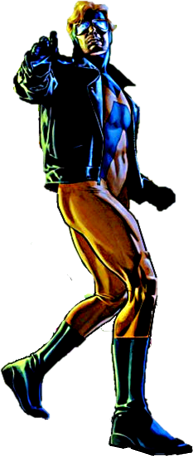
Animal Man is a superhero appearing in American comic books published by DC Comics. As a result of being in proximity to an exploding extraterrestrial spaceship, Buddy Baker acquires the ability to temporarily "borrow" the abilities of animals. Using these powers, Baker fights crime as the costumed superhero Animal Man.

Freedom Beast is a fictional comic book character appearing in American comic books published by DC Comics.
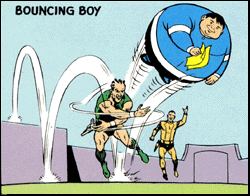
Bouncing Boy is a superhero appearing in American comic books by DC Comics, usually as a member of the Legion of Super-Heroes. Born on Earth, Bouncing Boy has the power to inflate like a giant ball and bounce around. This combination of invulnerability and velocity makes him a surprisingly useful combatant. Born without any powers, he received his abilities from a super-plastic formula he believed was soda. Bouncing Boy is known for sharing a long-term romantic relationship with fellow Legionnaire Triplicate Girl, whom he eventually marries. In reboot Legion continuity, he is the Legion's mechanic.

Son of Vulcan is the name of two comic book characters, one created by Charlton Comics in 1965, the other by DC Comics in August 2005. Son of Vulcan was one of the characters DC Comics purchased from defunct Charlton Comics in 1983.
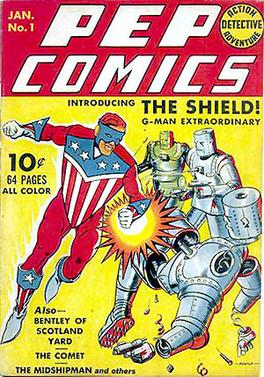
The Shield is the name of several superheroes created by MLJ. Appearing months before Captain America, the Shield has the distinction of being the first superhero with a costume based upon United States patriotic iconography. The character appeared in Pep Comics from issue #1 to #65.

Just Imagine... is a comic book line published by DC Comics. It was written by Stan Lee, co-creator of several popular Marvel Comics characters, in which he re-imagined DC superheroes, including Superman, Batman, Wonder Woman, Aquaman, Green Lantern, and the Flash.

Tarzanesque is a term created by Frenchman Francis Lacassin used to describe characters in comic books inspired by Tarzan. A tarzanesque character resembles Tarzan in his physical resourcefulness, within a line of action that includes an adventurous life in the jungle, the gift of understanding and being understood by animals, contact with lost civilizations and courage combined with the ability to deal with nature. The creation of such characters may have been propitiated by the success that Tarzan had achieved since his appearance in literature in 1912, culminating with the release of daily comic strips in 1929, which paved the way for a genre that combined the allure of the unknown environment, the need for the archetypal characteristics of the hero and the popularity of access.

Congorilla, originally a human character known as Congo Bill, is a superhero appearing in comic books published by DC Comics and Vertigo Comics. Originally co-created by writer Whitney Ellsworth and artist George Papp, he was later transformed into Congorilla by Robert Bernstein and Howard Sherman. The character first appeared in More Fun Comics #56.
Characters native to the African continent have been depicted in comics since the beginnings of the modern comic strip. Initially, such early 20th-century newspaper comics as Winsor McCay's Little Nemo depicted the racist stereotype of a spear-carrying cannibal, a comedic convention of the time. African characters later began to appear as another stereotype, the "noble savage"—a similar progression to that of depictions of Native Americans—and eventually as standard human beings.
George Edward Papp was an American comics artist best known as one of the principal artists on the long-running Superboy feature for DC Comics. Papp also co-created the Green Arrow character with Mort Weisinger and co-created Congo Bill with writer Whitney Ellsworth.

The Son of Tarzan is a novel by American writer Edgar Rice Burroughs, the fourth in his series of twenty-four books about the title character Tarzan. It was written between January 21 and May 11, 1915, and first published in the magazine All-Story Weekly as a six-part serial from December 4, 1915, to January 8, 1916. The story was first published in book form by A. C. McClurg & Co. in March 1917 and has been reprinted numerous times since by various publishers.
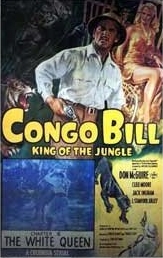
Congo Bill (1948) is a Columbia movie serial based on the DC Comics character Congo Bill, later named Congorilla.

Superboy is a superhero that appears in American comic books published by DC Comics. The character was created by Jerry Siegel and Don Cameron and is based on the character of Superman that Siegel co-created with Joe Shuster. Superboy first appeared in the comic book More Fun Comics #101 in 1945.
Black people have been portrayed in comics since the medium's beginning, with their portrayals often the subject of controversy. Mainstream comic publishing companies have had a historical trend of being predominantly white and male, reflecting the lack of representation and inaccurate depictions of Black people in comics. The integration of black characters in mainstream and superhero comics has endured various obstacles and challenges. Critics have noted that black men and women have historically often been portrayed as jungle or ghetto stereotypes, and as sidekicks as opposed to primary characters. Occiasionally, comic book creators would lampshade stereotypes, lack of representation and emphasize social injustices. In recent years, with the integration of more Black people in mainstream comic writing rooms as well as the creation of comics on digital platforms has changed the representation and portrayals of Black people in comics and has started to reflect the complexities of Black people across the diaspora.

Justice League: Cry for Justice is a seven-issue comic book limited series, written by James Robinson, drawn by Mauro Cascioli, and published by DC Comics in 2009. It follows the adventures of a spin-off Justice League, led by Justice League veterans Green Lantern and Green Arrow, and composed of Starman, Congorilla, Freddy Freeman, the Atom, and Supergirl. They are seeking a more proactive stand for seeking justice following the apparent deaths of long-standing Justice League members Batman and Martian Manhunter during the Final Crisis event.

David Rand is a fictional character appearing in American comic books published by Marvel Comics.
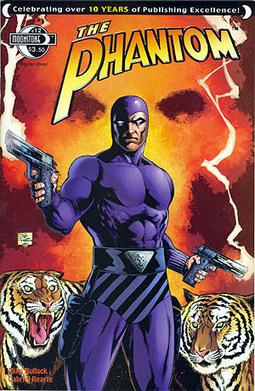
The Phantom is a fictional costumed crime-fighter who operates from the fictional country of Bangalla originally Bengali. The character was created by Lee Falk for the adventure comic strip The Phantom, which debuted in newspapers on February 17, 1936.
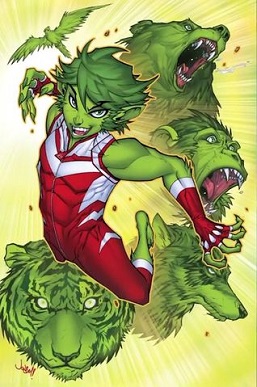
Beast Boy is a superhero appearing in American comic books published by DC Comics. He has also gone under the alias Changeling. Created by writer Arnold Drake and artist Bob Brown, he is a shapeshifter who possesses the ability to metamorph into any animal he chooses. The character first appeared in Doom Patrol #99 and is usually depicted as a member of the Doom Patrol and the Teen Titans.
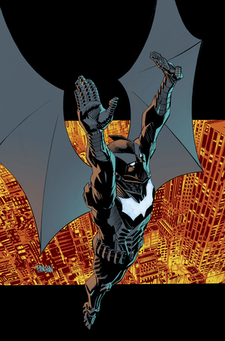
Batwing is the alias used by several characters in American comic books published by DC Comics. Both versions of the character are superheoes pattened by Batman, notable for their technological capabilities. The first Batwing is David Zavimbe, a Congolese police officer, created by writer Grant Morrison and debuting in Batman Incorporated#5 in May, 2011 before headlining his own Batwing comic series. This version of Batwing acts as one of representatives of Africa within Batman Incorporated, being known as the "Batman of Africa". The second Batwing, Lucas "Luke" Fox, is an African-American mixed martial artist and genius who is the son of Lucius Fox, one of Batman's closest associates. After David retires from the role, Batman offers the Batwing role to Luke, who is eager to accept despite protest from his father.
















